The Land Of China -- Explore by Province
Ningxia
Ningxia Hui Autonomous Region lies south of Inner Mongolia. Hui is a minority in China, and they are descendants of Moslems who came to China 700 years ago and later settled in China. The Region was founded in 1958.
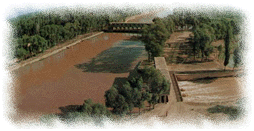 a Canal in Ningxia
a Canal in Ningxia
|
The capital city, Yinchuan (Silver Plain), is a few kilometers west of the Huang He. It is surrounded by canals in the plains yet is close to mountains and sand deserts. It was inhabited 30,000 years ago, and 8000 year-old neolithic relics have been found in the capital city. The city of Yinchuan was founded in the Tang dynasty. It was the capital of Western Xia for 190 years, which was destroyed by Genghis Khan. No records of that country are left. Today, there are nine imperial tombs, imposing dagobas and pagodas, mosques, and canals. All are very unusual and impressive. There is Shapatou (Sand Hill), a sand hill that arises abruptly by the Yellow River, where visitors can enjoy sand-sliding, a sport rarely found elsewhere. Yinchuan is a place of adventure, ancient mystery, and primitive charm. Yinchuan produces good-quality sheepskin.
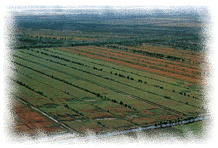 Ningxia Plains
Ningxia Plains
|
One of the most important agriculural regions in the upper reaches is the Ningxia Plain, which is benefited by the river water through gravity-fed irrigation. Lying along the Silk Road and in prosperity since ancient time, the Ningxia Plain remains to this day to be the grain silo of China's barren west. The irrigated plain borders the Tenggeli Desert on its west.
 the Nanguan Mosque
the Nanguan Mosque
|
The Nanguan Mosque was built at the end of Ming Dynasty in the southeast corner of Yinchuan's old city. The present building, which was rebuilt in 1980 and 1981 covers an area of 2,074 square meters. It is conspicuously Islam in architectural style and has distinctive national features. The mosque is composed of upper and lower levels and its plump, green domes reach a height of 22 meters. The Great Prayer Hall in the upper level can accommodate 1,000 people. The lower level contains bathing houses, a secondary prayer hall and residences for the imams.
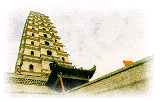 the Haibao Pagoda
the Haibao Pagoda
|
The Haibao Pagoda is found in the north edge of Yinchuan City. When it was built is anyone's quest. Historical accounts note it was rebuilt by He Lian Bebe, (the ruler of Xia Kingdom, 407 - 427). It is 53.9 meters high, has 11
floors, is made of brick and is square in shape. The niches in every story slightly protude and consequently many edges are formed giving the tower the look of the Chinese character. Its style is unique among the thousands of pagodas of China. Its rooms are also square. The gates face east and four arches lead to the four sides and there is a wooden ladder by which you may climb up to the ninth floor.
 the Western Xia Mausoleum
the Western Xia Mausoleum
|
The Western Xia Mausoleum is located on the eastern slope of Helan Mountain in the western suburbs of Yinchuan City and contains the tombs of emperors of the Western Xia. It is 10 km long from south to north and four km from east to west. Nine tumuli of emperors and some 140 annex tombs are scattered throughout the area. Every tumulus is a complete structure, and some are as big as 100,000 square meters. They all have watchtowers, quetai, saced walls, stele pavilions, outer cities, inner cities, Xiandian halls and pagoda-like lutai. Only one of the tumuli and four annex tombs have been excavated up to now.
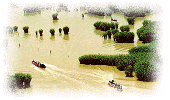 the Shahu Lake
the Shahu Lake
|
The Shahu Lake Tourist Area is a popular recreational area 56 km north of Yinchuan City. It is made up of 660 hectares of lake and 300 hectares of golden desert. Visitors may boat among the reeds on the lake. In the middle of the lake is a small island, about one hectare in area. Every year, hundreds of thousands of migratory birds come to rest and breed on the island. This is a unique scenic spot that combines the mild beauty south of the Changjiang (Yangtze) River and landscape of the desert north of the Great Wall.



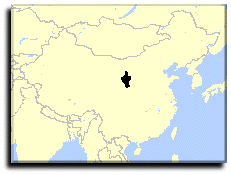










 Chinese Culture
Chinese Culture